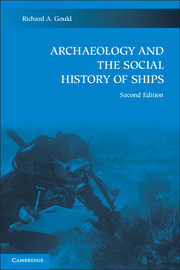Book contents
- Frontmatter
- Contents
- List of figures
- List of tables
- Acknowledgments
- Introduction: Toward a higher standard
- 1 Interpreting the underwater archaeological record
- 2 Underwater archaeology: The state of the art
- 3 Ships and shipwrecks: Basic mechanics
- 4 The archaeology of small watercraft
- 5 The earliest ships
- 6 Shipwrecks and our understanding of ancient trade
- 7 Sailing ships of the Middle Ages
- 8 Ships of the great age of sail
- 9 From sail to steam in maritime commerce
- 10 New technologies and naval warfare
- 11 The archaeology of maritime infrastructure
- 12 The future of shipwreck archaeology
- References cited
- General index
- Ship and site index
8 - Ships of the great age of sail
Published online by Cambridge University Press: 05 June 2012
- Frontmatter
- Contents
- List of figures
- List of tables
- Acknowledgments
- Introduction: Toward a higher standard
- 1 Interpreting the underwater archaeological record
- 2 Underwater archaeology: The state of the art
- 3 Ships and shipwrecks: Basic mechanics
- 4 The archaeology of small watercraft
- 5 The earliest ships
- 6 Shipwrecks and our understanding of ancient trade
- 7 Sailing ships of the Middle Ages
- 8 Ships of the great age of sail
- 9 From sail to steam in maritime commerce
- 10 New technologies and naval warfare
- 11 The archaeology of maritime infrastructure
- 12 The future of shipwreck archaeology
- References cited
- General index
- Ship and site index
Summary
It has been suggested that if a sailor from the days of the Spanish Armada in 1588 could have been transported forward through time to the deck of a sailing ship in the mid- to late-19th century, about 300 years later, he would have been familiar with the sails, rigging, and general character of the ship and could have proceeded about his duties without delay or specialized training. The various European cultural traditions that emerged over this 300- to 400-year period eventually settled on a class of ship, the galleon, that was to dominate overseas colonization, trade, and war. The galleon was the product of processes of cultural selection during the course of numerous voyages of exploration, fishing, whaling, and initial colonization that encompassed the New World, Africa, and Asia (with a few unplanned excursions to Australia). Events in Europe also had a direct bearing on the course of overseas empire, especially in the head-to-head competition between Spanish and English seafarers, and underwater archaeology has profoundly influenced our understanding of the nature of this competition. The final phase of the European transition from medieval to postmedieval maritime culture from the 14th to the mid-16th century, received a strong impetus from the societies of the Iberian Peninsula – the Spanish, Portuguese, and the Basques – along with influences from the Genoese and the Venetians.
- Type
- Chapter
- Information
- Archaeology and the Social History of Ships , pp. 209 - 247Publisher: Cambridge University PressPrint publication year: 2011



